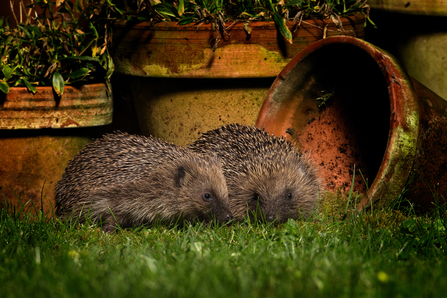
Hedgehogs - Jon Hawkins/Surrey Hills Photography
Urban areas can be a haven for hedgehogs – if gardens are managed with wildlife in mind. You don’t have to have a messy garden, but leaving wild corners and patches will really help. Any type of garden can be made more hedgehog friendly with a few easy changes.
1 - Hedgehog Highways
Hedgehog Highways are small, ground level access points to your garden or green space. These are easy to make and can come in all sorts of forms, from a hole cut out of a wooden fence, a gap under a gate, clipping of a wire fence, a tunnel dug under a fence, to a hole created by a contractor in a newly installed concrete gravel board. If you have an existing concrete gravel board, you can make a hole in the wooden fence and use bricks to create steps up to the access point. These holes or gaps should be the size of a CD case, or 13cm x13cm.
If you are worried about pet dogs using the hole, another option is to use a cinder block so that the hole is more of a tunnel. The hole could also be blocked up whilst your pet is outside, and unblocked again once your pet is safely inside, or the height of the hole reduced, so long as the width is increased.
2 – Feeding
Hedgehogs are omnivores but rely largely on macro-invertebrates such as beetles, spiders, worms and earwigs. Habitats that encourage these invertebrates will be great feeding sites. Keeping fallen leaves on the ground, creating log piles, having compost heaps and managing nectar-rich wild flower patches will all help!
A hedgehog’s natural diet can also be supplemented with a bowl of wet cat or dog food (not fish flavoured). This is especially helpful in cold weather when invertebrates may be scarce. Best to avoid putting out bread and milk as hedgehogs are lactose intolerant and so this will make them ill.
You can even make a feeding station so that cats and dogs are not able to eat your hedgehog’s food, find out how, here.
3 – Nesting
Availability of suitable wintering sites is a large limiting factor for hedgehog distribution across the UK. Winter nests need support structures, such as log piles or bramble patches. They also require medium sized leaves such as beech or oak. These leaves don’t break down as quickly as others and will fit together nicely in their tightly packed 50cm wide wintering nests.
Whilst we would always encourage creating natural nesting opportunities for hedgehogs, a fun activity can be to build a hedgehog home! Why not try both? Some designs can be found here.
4 – Chemical free
The impact of slug pellets on hedgehogs is a complex and still discussed issue. We do know for sure that any chemicals impacting the invertebrates that hedgehogs rely upon will mean less food, so less hedgehogs.
Hedgehogs (and other species such as frogs and toads) love the species you probably hate – slugs! Encouraging hedgehogs into your garden will be benefiting the environment and helping you with pest control. Additional alternatives to slug pellets can be found on the Hedgehog Street website here.
5 – Think hedgehog!
Strimming incidents are common. Always thoroughly check the area you are cutting. Making a high cut, followed by a low cut will help to reduce the chance of injuring or killing any hedgehogs present. Similarly for bonfires, always check for wildlife first! We recommend making your bonfire on the day it is being burnt, so hedgehogs and other species don’t starting using it as a nesting site first. Steep sided ponds are also an issue. Hedgehogs are good swimmers, but will drown if there is no escape route. Shallow ends or a pond ramp will help hedgehogs get out. Check too for netting, which hedgehogs can get tangled in if it is not well pegged down.
More wildlife gardening tips can be found in our Advice Directory .
